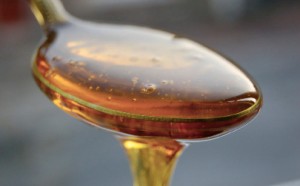Barley malt, brown rice syrup, honey, date sugar, sucanat, maple syrup, fruit concentrates, stevia and agave nectar. Sweeteners used in baked goods, desserts, some more refined than others.
Agave nectar is made from the same plant that is used to make tequila. It grows wild in the Mexican state of Jalisco, and has been used medicinally for thousands of years.
The agave plant stands 5-8 feet tall (1.5 to 2.4 m) and has a diameter up to 12 feet (3.6m). It must be 7-10 years old before it is ready for harvesting. When harvesting, the plant is severed from its roots, spiky leaves removed leaving behind a pineapple shaped chamber called the pina. It is capped with a stone and a milky juice is extracted from its centre. The juice is cleaned and filtered to produce the liquid that will become agave nectar.
It is important to look for USDA – certified organic products when shopping for agave nectar. Most of the agave sold in Canada is imported from Mexico and shipments have been refused due to excessive pesticide residues. Check for the USDA – certified organic seal or Quality Assurance International (QAI) certified organic stamp. They are an independent, global organic certifier with an excellent reputation.
Agave is valued as a vegan alternative to honey and recognized for its low glycemic index.
What does this mean?
Foods with a higher glycemic index (GI) tend to trigger a greater rise in blood sugar. The lower the GI, the more slowly the food is processed and the less dramatic the fluctuations in blood sugars and insulin levels.
According to a study in the American Journal of Clinical Nutrition, agave’s GI value is 5 times lower than table sugar’s. It packs 20 calories per teaspoon, five more than granulated sugar but is sweeter than sugar so you can use less.
When substituting agave nectar for sweeteners in a recipe, reduce the other liquids by one-third. When replacing ordinary sugar, use ¾ cup agave nectar for every cup of sugar. When using honey, replace with a 1:1 ratio. Baked goods brown more quickly, so reduce oven temperatures by 25 degrees F (14C) to avoid burning.
With a 3-year shelf life, agave will not crystallize nor solidify when cold. Sold in light, amber, dark and raw varieties, the choices now extend to flavoured varieties such as Irish Crème, Hazelnut, Cappuccino and Amaretto. Used in mixed drinks, ice cream, pancakes and as a sweetener for coffee and tea, agave has found a new niche for consumption.
More expensive than sugar, but so much better for your health!
My 11.75 oz (333g) plastic bottle of agave nectar cost around $7.00. Visit health food stores that sell it loose leaf. Buy a small amount and if it becomes a part of your whole foods pantry, then buy a larger amount. Move over vanilla, agave is the next best ingredient to surface from Mexico.





One Response to “Agave Nectar- Naughty or Nice?”